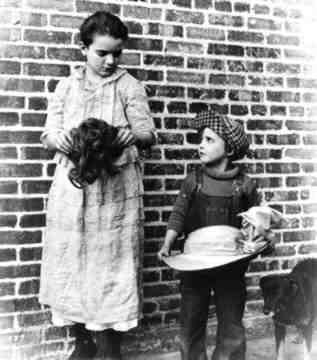
Figure 1.--Jackie Coogan and Charles Hatton are seen here in a scene from Peck's Bad Boy. |

|
Child star Jackie Coogan is a boy who can't stay out of trouble. The movie is based on George Wibur's Peck stories. It was made immediately after the the Coogan-Chaplom blockbuster -- 'The Kid'. This film was made without Chaplin.
A circus comes to a small quiet town where Mr. Peck's bad boy Henry (played by Jackie Coogan)
and his dog "Buddy" (played by Queenie) reside. Kids get restless at the drop of a hat, so Buddy,
Henry and Henry's best pal (played by Charles Hatton) visit the circus. Their mischief causes a near
riot when they release a lion from its cage. Our darling little hellion, Henry, is adored by his Mamma
(played by Lillian Leighton). However, his Papa (played by James Corrigan), the local store keeper
(played by Raymond Hatton) and the rest of the town all know trouble's penchant for finding Henry
Peck.
In other escapades, Peck's bad boy rescues Buddy and every other stray dog from the dogcatcher.
He disrupts Sunday's church service with some naughty "ant"ics played on his own, dear dad. But his
biggest prank is saved for his sister's suitor, the young Dr. Martin (played by Wheeler Oakman), that
results in his arrest! Peck's bad boy occasionally tries to be a good boy, but he just can't help getting
into hot water - or the grocer's displayed merchandise to fill his hollow leg (fortunately, the grocer
keeps a running tab for Mr. Peck!).
'Pecks Bad Boy' was based upon the popular newspaper sketches of 'Peck's Bad Boy and His Pa', by George Wilbur Puck, in 1883. The newspaper series had been adapted into a stage play and was a tremendous hit that ran for several years. This film's inter-titles were written by well-known humorist, Irvin S. Cobb.
'Pecks Bad Boy' was Jackie Coogan's first film released on the enormously successful heels of 'The Kid' (Charlie Chaplin Productions, for First National, 1921), with Charlie Chaplin. Chaplin had discovered and coached Jackie. Even though the critics were less than impressed with the story line, they loved Coogan and so did his fans. The public ate up little Jackie and his engaging personality with a spoon. He integrated his own charms with a bright, acting polish from his tutelage under the great Chaplin. The film received favorable reviews. Variety, on April 28, 1921, stated, "Peck's Bad Boy as a picture will not go down in history as a great achievement. It is just a picture, and it is more than likely that the producers of it didn't expect to do more than present simply a picture of Jackie Coogan, and in figuring that he was enough they
were probably right." Photoplay, in July of 1921, exclaimed, "It is a rare acting talent and a lovable personality that Jackie Coogan brings to the screen. But his directors will be hard put to it to find stories to fit him. Probably never again will he have the chance that Charlie Chaplin gave him in 'The Kid'." Harrison's Reports, for April 30, 1921, said, "The young generation and the majority of adults will
no doubt enjoy this picture; it is only those who like to be made to think deep that may not be
satisfied with it. There are many situations in it, which, although old, create good laughs."
Jackie Coogan related decades after making the picture that he really enjoyed the experience.
'Peck's Bad Boy' was the first film he made fresh from his triumph with 'The Kid' (Charlie Chaplin
Productions, for First National, 1921), starring Charlie Chaplin. Coogan was the first of the great child stars and the greatest of
the silent era.
Other members of the cast included Wheeler Oakman Doris May, Raymond Hatton, James Corrigan, Lillian Leighton, Charles Hatton, GloriaWood and Queenie, a dog. Directed by Sam Wood.
Wheeler Oakman made his screen debut in 1913 with Selig Polyscope after a stage career. He
made about 70 silent feature films and can be seen in The Spoilers (Selig Polyscope Company,
1914), starring William Farnum; Mickey (Mabel Normand Feature Film Company, 1918), starring
Mabel Normand; and Outside The Law (Universal-Jewel, 1921), starring Lon Chaney.
Director Sam Wood (1883 - 1949) began his film career after a stint as a real estate broker. As an
actor, he appeared in a few two-reelers in 1908 under the name of "Chad Applegate." In 1915,
Wood became an assistant director to Cecil B. DeMille and, by 1920, he was a top director at
Paramount. While at Paramount, he directed several Gloria Swanson pictures (10 in a row),
including the now lost film Beyond the Rocks (Famous Players-Lasky, 1922), with Rudolph
Valentino. He later joined M-G-M and directed such stars as Marion Davies, in The Fair Co-Ed
(A Sam Wood Production, for Cosmopolitan, released through M-G-M, 1927). When the talkies
arrived, Wood's career blossomed further. He directed many fine films, including some of the
best-known classics from the 1930s and early 1940s: Paid (M-G-M, 1930), starring Joan
Crawford; two Marx Bros. films, A Night at the Opera (M-G-M, 1935) and A Day at the Races
(M-G-M, 1937); Goodbye Mr. Chips (M-G-M, 1939), with Robert Donat; Kitty Foyle (RKO,
1940), with Ginger Rogers in an Oscar winning role; and Kings Row (Warner Bros., 1942), starring
Ronald Wilson Reagan. Wood also directed several Gary Cooper films: The Pride of the Yankees
(RKO, 1942), For Whom the Bell Tolls (Paramount, 1943), and Casanova Brown (RKO, 1944).
Sam Wood was a thorough professional, like a disciplined sentry in a director's chair. Working up to
the end of his life, he was only relieved of his post when he was felled by a heart attack.
Navigate the Boys' Historical Clothing Website:
[Return to the Main movie page]
[Return to the Main alphabetical movie page]
[Introduction]
[Chronology]
[Clothing styles]
[Activities]
[Countries]
[Biographies]
[Bibliographies]
[Contributions]
[Boys' Clothing Home]
